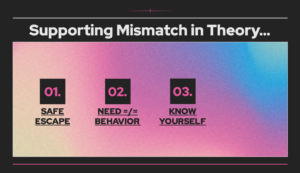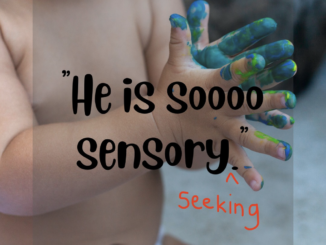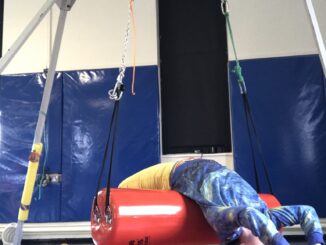Here’s my third tool for dealing with sensory mismatch in your family, home, school, or work environment. If you’ve missed the first two posts (one, two), check those out first — it may help you understand what’s being discussed in this one.

Adults should raise their awareness of their own sensory needs. This can be really tricky if you weren’t raised in an environment that taught you any of this stuff – which, let’s be honest, basically zero of us were. I still think that this is important self-discovery. Many people come to my content because they are hoping to find out information that will help them understand their children, but here I am saying that you should find out information that will help you understand yourself.
The reason that I say this is an important tool is because it means that you can begin modeling it, talking about it in front of your kids and giving them the ground-level awareness that adults live sensory lives in their own bodies too and that it is normal to adapt the world around you and your life for your sensory needs. And also, because it means that you can be more confident in meeting your own needs and have the language and awareness to know that you’re doing it intentionally and more frequently, which means that you’ll have more resources and regulation available in your own body to help your kids.
I know there are also people who read this page who do not have kids or work with kids, but are reparenting themselves or just figuring out their own stuff. This is your time to shine, then! Regardless of whether you’re “here for kids” or “here for yourself” or “here for both”, I’ve got a whole category on my website for “self/adult” so you can read all of the things that are geared towards adults.
You can figure out what your own “feel-good strategies” are – the things you build into the day to help yourself stay feeling good.
You can figure out what your own “emergency coping strategies” are – the things you do when things are starting to go south and you need to help yourself try to cope through it.
For me, some of my feel-good strategies are flapping my hands or shaking my wrists, listening to my favorite music, verbally singing silly little made-up songs to myself, fidgeting with the fidget on my keychain, walking outside for any minutes of the day, running my hands through my own hair, fidgeting with my fidget ring or any of my other fidgets and toys on my desk/backpack/keychain, and taking deep breaths and bonus points if it’s with a candle.
Some of my emergency coping strategies are putting in earplugs, running cold water over my wrists, taking off a layer of clothes or pointing a fan at myself (because my body gets hot and feels hot when I’m overwhelmed and that can cause a sensory “feel-bad” feedback loop as I feel worse — get hotter — feel worse), running my hands through my own hair, or whispering everything I’m trying to say.
These have taken me years and trial and error to figure out; they’re not just something that I inherently know or even that I found out by virtue of being an OT. They took intentional time and exploration and self-discovery and you can totally also do all of those things.
How do you test out different feel-good strategies? Are there things that you know make you feel good, that you wish you had more of? Start by intentionally building time for 1 more of 1 of them in your days and see how it affects your feeling of living in your body. Do you have absolutely no idea? Start by googling a list of “sensory input” and go through the list one thing at a time, or take the list of 8 senses — sight, smell, hearing, taste, touch, proprioception, vestibular, interoception — and try doing 1 thing that targets 1 sense, 1 time a day, and see if you like any of them.
How do you test out different emergency coping strategies? If you can think of anything that would “fix an emergency”, then figure out what tool would help fix it (like earplugs) and give yourself easy access to that tool, voila, you’ve just implemented an emergency coping strategy. If you can’t think of any “fixes”, here’s something you could try. Find a shocking, alerting sensory strategy that you do not find unpleasant — not that hurts you in any way or you want to avoid — just something that is very alerting to the senses. Some examples of this could be tasting a strong mint flavor, spicy flavor (i.e. cinnamon), or sour flavor (i.e. candies); running cold water over your hands; eating something cold like an ice cube; jumping up and down with both feet flat; making a spinning, rocking, or other rapid movement motion (e.g., lying down on the floor) in a safe way. Pick one strategy and start with that. When you’re in a moment where your body starts to feel like it might get out of control, doing a “shocking” sensory input can give your system a very different sensory input than the one it was about to focus on. I can’t say this too many times: DO NOT do this in a way that hurts yourself or that you find unpleasant! If anything, it should be an enjoyable alerting experience.



